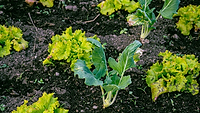Nanofortification Could be Promising New Technique for Inhibiting Pathogen Growth on Crops

Image credit: Andhika Y. Wiguna via Unsplash
University of Texas at El Paso (UTEP) researchers have developed a novel method for inhibiting Escherichia coli growth in rice crops.
The method involves fortification of rice grains with zinc oxide and magnesium oxide nanoparticles, which effectively disrupt the cell membranes and metabolic processes of E. coli to prevent the pathogen’s proliferation. The performance of zinc oxide and magnesium oxide nanoparticles in stopping bacterial growth was found to be more effective than the performance of their ionic forms, magnesium sulfate and zinc sulfate. Through experimentation, the researchers identified the best techniques for applying different types of nanoparticles and accurately testing their efficacy, and they replicated their work several times to validate their results.
The researchers believe that, not only is their novel method applicable to E. coli on rice crops, but it also has the potential to advance food safety technologies for other agricultural commodities. They suggested that the incorporation of nanofortification into standard food safety practices could help industry better protect crops against microbial contamination, as well as bioterrorism threats.
As part of their research, the UTEP team also discovered that Mexican brown rice is the most resilient type of rice against pathogens, due to its higher essential mineral content, its inherent phenolic compounds (i.e., organic compounds with antioxidant characteristics), and other microbial agents present on the rice.
The project was led by Hamidreza Sharifan, Ph.D., Assistant Professor of Chemistry and Biochemistry and prominent researcher at UTEP. He was joined by Daisy Wilson, a Ph.D. student in environmental science and engineering, and Valeria Gonzalez, a senior undergraduate student in forensic science. The work was supported by the U.S. Department of Homeland Security, which offered an internship to Ms. Wilson and Ms. Gonzalez, who, under the mentorship of Dr. Sharifan, were charged with developing biofortification techniques to address microbial contamination.
The researchers hope to see their work published in a peer-reviewed journal by the end of October 2024 and are optimistic about the impact their research will have on food safety.
Looking for a reprint of this article?
From high-res PDFs to custom plaques, order your copy today!







